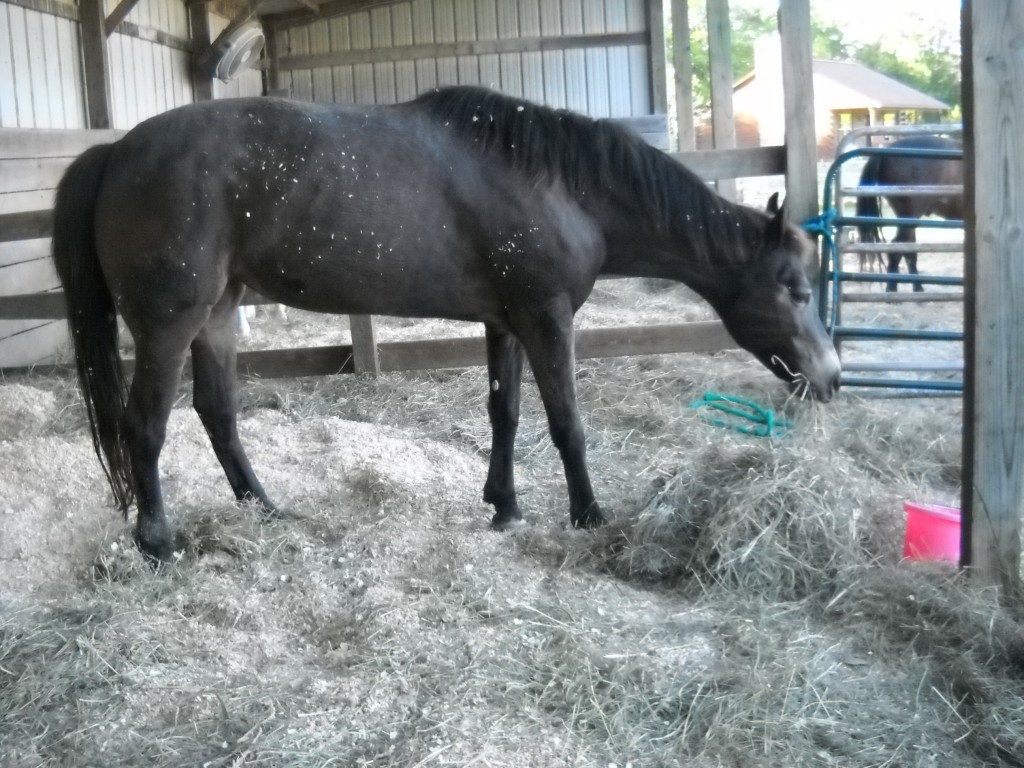Laminitic horses can develop severe osteoporosis in their long pasterns

Angel on May 4, 2011. She was put down two days later. Her X-rays showed that her coffin bones in both front feet were half gone and she had developed a facture in her left coffin bone. She had managed to get around for years by carrying the bulk of her weight in her hind end.
In my mare Angel’s final few years with laminitis before dying in May 2011, the focus shifted a little from her front hooves to her long pasterns, what I think of as her ankles, sometimes called “P1.” She developed pretty severe osteoporosis in her front long pasterns, and the veterinarian who took over her case was more than a little concerned about her trotting or galloping and having something catastrophic happen to her legs.
In Angel’s X-rays during that time, her long pasterns should have been white, but they were pretty dark other than a white outline showing the edges. I’m no radiology expert, but if white represents healthy bone, dark gray to almost black can’t be good.
Of course, this osteoporosis was in addition to all sorts of bad things happening to her coffin bone two bones away.
Angel’s vet said the osteoporosis in the long pastern was due to lack of weight-bearing on the front legs. Over the years, Angel did get very comfortable carrying most of her weight behind, and she could spin on those hind legs like nothing I had ever seen. Given the severity of her case, she likely would have been put down by most vets early on. And her final vet was surprised that she was still alive but agreed with me that as long as Angel had such a sunny and positive outlook, there was no need to make any drastic decisions “in her best interest.”
The fact that Angel made it seven years led to developments in her that might not be well-documented or studied. I have found no research on long pastern osteoporosis.
I did find two studies that looked at the bony changes in the distal phalanx, or coffin bone, often referred to as P3, which is connected to the laminae in the feet. This is the bone that usually changes position in the foot. The bone should be shaped similarly to a hoof and fit in perfect alignment in its cavity inside the hoof.
In 1987, researcher Robert Linford looked at bone changes with trauma- and carbohydrate-related laminitis. He said changes in the laminae were likely to cause changes to the bony structure in the coffin bone.
In 2010, researcher Julie B. Engiles published a 10-page paper in Veterinary Clinics of North America: Equine Practice and mentioned that she was picking up where Linford had left off, as no other research in the interim appeared to study the deterioration of the coffin bone during laminitis.
She said developments seen in humans due to inflammatory conditions or alterations in biomechanical forces lead to active bone remodeling as well as medullary edema and other changes, and these changes are similar to what is seen in the distal phalanx in horses with laminitis.
The medullary cavity is the center of the bone shaft where marrow is found.
Engiles concluded that the coffin bone should be considered, perhaps in addition to the laminae, as a continuing source of pain and self-perpetuating inflammation.
In Angel’s case, the front half of her coffin bone just eventually wore away, leaving her with half a coffin bone. When Angel’s vet took her last set of X-rays and turned around to look at the monitor, the words “holy bananas” were out of her mouth before she could stop herself. Holy bananas told me everything I needed to know. Some problems even the sunniest of horses can’t overcome.